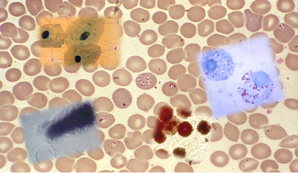LYME BORRELIOSIS: Co-Infections Associated With Lyme
|
Bacteria / Protozoan Collage on Right:
Background photo: Babesia protozoa infecting red blood cells Top Left (Orange) : Chlamydophila pneumoniae Bottom Left (Blue) : Bartonella Central (Red) : Mycoplasma Far Right (Blue/Purple) : Rickettsia |
Co-infections Associated with Lyme Borreliosis: As Borrelia is transmitted by arachnids, there is the possibility of acquiring various parasitic, bacterial and viral infections with one bite.
|
Infections associated with Lyme Borreliosis / Vector Borne Diseases
As Lyme is a vector borne disease (see: Lyme Transmission and Maintenance), there is the possibility of acquiring other infections that may be transmitted at the same time. These include: parasitic infections such as Babesia/Theileria and bacterial infections such as Bartonella and the Rickettsial diseases – Rickettsia (either: typhus group, spotted fever group or scrub typhus), Ehrlichia, Anaplasma and Coxiella (Q fever). Immuno-compromised individuals may also be more susceptible to acquiring opportunistic bacterial infections such as Mycoplasma and Chlamydophila pneumoniae (CpN) and viral infections such as Epstein-Barr virus (EBV), and ParvoB19.
Co-infections are mentioned briefly here to note that acquisition of one or more of these infections at the same time may alter the severity/course of Lyme disease. It is also noteworthy that whilst other countries recognise that infections due to pathogens such as Babesia, can cause severe illness in humans as well as animals (and can be transmitted via blood transfusions), Australia is yet to acknowledge the potential risks for human disease, even after the death of a NSW male in 2011.
Co-infections are mentioned briefly here to note that acquisition of one or more of these infections at the same time may alter the severity/course of Lyme disease. It is also noteworthy that whilst other countries recognise that infections due to pathogens such as Babesia, can cause severe illness in humans as well as animals (and can be transmitted via blood transfusions), Australia is yet to acknowledge the potential risks for human disease, even after the death of a NSW male in 2011.
The short section on Co-Infections above has been reproduced from the 'Lyme Borreliosis: Clinical Picture Symptoms' segment.
Additional information on the individual co-infections and their status in Australia is being added (see below) as time permits.
Additional information on the individual co-infections and their status in Australia is being added (see below) as time permits.
Click on the links (name of organism) below to see more about the various pathogens, including current status in Australia, as well as the symptoms that are associated with infection..
BABESIA
Further information on Co-infections can be seen at:
What is Lyme: Lisa Hilton's Blog
Lyme Disease Organisation
A Chart of numerous co-infections compiled by Louise Jenner.
What is Lyme: Lisa Hilton's Blog
Lyme Disease Organisation
A Chart of numerous co-infections compiled by Louise Jenner.


